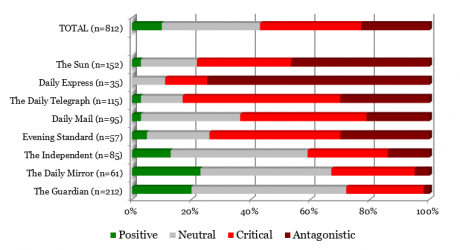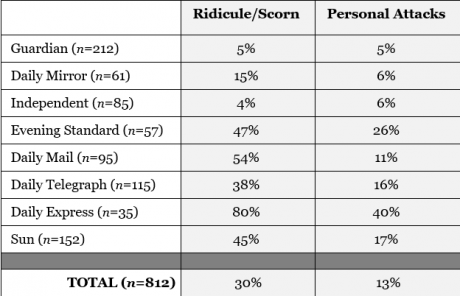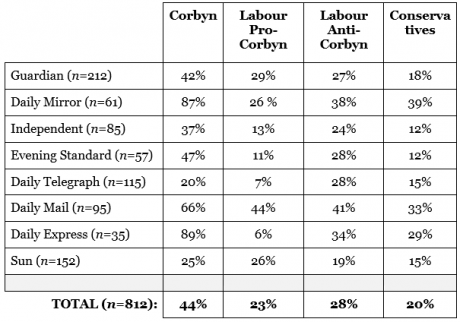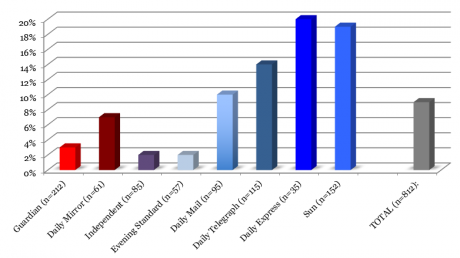Jeremy Corbyn has been variously described in the British press as unelectable, comic and highly dangerous. How should a healthy democracy respond to politicians pursuing a different kind of democracy?
When the British Labour Party voted for a new leader in September 2015, they also voted for a different kind of politics, one might even argue that they voted for a different kind of democracy. Jeremy Corbyn, elected on the 12 September 2015 as Labour Party leader, could in many ways be considered as a political maverick, a political transgressor and deviator who refuses to align himself with the mores and quirkiness of the British political establishment. However, the way the British mainstream media reacted to him could likewise be denoted as transgressive and highly problematic from a democratic perspective. From the moment he became a serious contender and going in overdrive in the months after his election as party leader, Corbyn was clobbered by the British mainstream media in quite astonishing ways.
At the same time, in a democracy the media has a legitimate role to critique and to question authority. Our study – a representative content analysis of the representation of Corbyn by eight British newspapers (n=812 articles) – aimed to capture and acknowledge this legitimate monitoring role of the media, while also identifying where and in what way the British media transgressed into behaviour unworthy of a democracy.
Our analysis found that more than 50 per cent of news reporting about Corbyn from 1 of September 2015 until 1 of November 2015 was critical or blatantly antagonistic. That’s news coverage – the supposed bastion of journalistic factual reporting and balanced impartiality. A healthy democracy, according to the Independent Press Standards Organization (IPSO), requires a press that is “free to editorialise and campaign” – but newspapers “must distinguish clearly between comment, conjecture and fact,” insists the press regulator. And newspapers are also obliged to “make a clear distinction between comment, conjecture and fact.” The analysis of our data shows that in the case of Corbyn this distinction became very blurred. Furthermore, when it comes to opinion and editorials these were heavily skewed against Corbyn with almost 70% of all opinion pieces and editorials being critical or antagonistic and deligitimising (see Figure 1).
Figure 1: Overall Tone of the Article

IPSO furthermore insists that its members have a “duty to maintain the highest professional standards” and “take care not to publish inaccurate, misleading or distorted information”. Whereas Corbyn’s voice and ideas are absent in over 50 per cent of the coverage on him, when it is present, his views are very often distorted or taken out of context. This is the case for 22 per cent of the total coverage (see Table 1).
Table 1. Reproduction of Corbyn’s views

Besides this, we also found that three in ten pieces in the British print media mock the leader of the opposition, scoff at his ideas, policies, history — including his looks (see table 2). Our analysis of news reports about Corbyn found that the long-serving Member of Parliament for Islington North frequently gets reduced to the journalistic shorthand of a caricature in much of the news coverage. He is often portrayed as a clown-like figure, mocked as the ‘Jezster’ or derided as the comic political equivalent of the child-like TV sitcom character Mr. Bean with tabloid media repeatedly referring to him as ‘Mr. Corbean’.
So much of the news media coverage of the Labour leader is maliciously personal. A week after his election as leader, The Daily Telegraph artfully condensed all of its sneering criticisms into a few short sentence, describing him as:
Table 2: Ridicule, scorn and personal attack by newspaper

Repeatedly, news and commentary suggest Corbyn’s sartorial and lifestyle choices make him decidedly unelectable. Corbyn is consistently portrayed as a political transgressor, a maverick who isn’t playing ‘the game’ in the way the media and the political establishment expects from a leader of the opposition. While it is the role of the media to be critical and fulfil a monitoring role, in the case of Corbyn the media has also transgressed into vile attack dog journalism.
As has been apparent in the data presented above, there is an obvious ideological bias here, with the rightwing media (in our study: Evening Standard, Daily Mail, Daily Telegraph, Daily Express, and Sun) being more acerbic, more scornful, mocking gleefully, attacking Corbyn more on a personal level, etc. than the leftwing media (in our study: Independent, Guardian and Daily Mirror).
However, we also observed a lot of negativity towards Jeremy Corbyn in the leftwing press, considering him too left, unrealistic, unelectable, etc. Part of this is the amplification of the civil war within Labour (see Table 3). This is especially apparent in terms of the sources used in the reporting on Corbyn. Anti-Corbyn Labour sources tend to outweigh the pro-Corbyn Labour sources (28 per cent of articles uses the former as a source versus 23 per cent for the latter), this is especially pronounced in Daily Express (34 per cent anti and only 6 per cent pro) and in The Daily Telegraph (28 per cent anti versus 7 per cent pro). However, in more left-leaning newspapers such as The Independent and The Daily Mirror discrepancies can also be observed (24 per cent anti versus 13 per cent pro-Corbyn Labour sources in the Indy and 38% anti versus 26 per cent pro in the Mirror).
Table 3: Sources used in the reporting on Jeremy Corbyn

However, in our view the most problematic result emerging from our analysis, is that the British media has actively and vigorously sought to delegitimise the leader of the largest opposition party in the UK. This was done, as shown above, through scorn, ridicule and personal attacks (especially relating to his clothing, lifestyle and love life), but above all by strongly associating Corbyn with condoning terrorism and depicting him as a friend of the enemies of the UK (See Figure 2).
Figure 2: Association with IRA, Iran, Hamas, Hezbollah and/or Terrorism

Almost 10 per cent of the articles relating to Corbyn had a reference to Iran, Hamas, Hezbollah, IRA and/or terrorism in general, especially in the Daily Telegraph (14 per cent), The Daily Express (20 per cent) and The Sun (19 per cent) this association was very pronounced. Linked to this, was the strong depiction of Corbyn as a danger or his ideas as dangerous (22 per cent of the articles carried this frame). This danger frame was not only fed by journalists (9 per cent), but also by the Tories and Cameron (4 per cent), and by anti-Corbyn Labour sources (6 per cent), again an indication of the civil war raging within Labour.
Corbyn certainly appears different from the generations of cookie cutter politicians the UK has grown used to over the last few decades. The Labour leader doesn’t play the game and he remains unwilling to submit to what the media and the political establishment expect from a leader of the opposition and prime minister in waiting. In response, the British media have vilified Corbyn, assassinated his character, ridiculed his personality and delegitimised his ideas and politics, only then to subsequently blame him for his own negative media representations and his “toxic” relationship with the media.”
What the UK newspapers have done – and continue to do – to the Labour leader has grown beyond a political question — it now also raises ethical and democratic ones. A healthy democracy, to be sure, requires a strong watchdog in its press – but not an attack dog, snarling and barking at a different looking and distinctive talking politician that happens to challenge the status quo and advocate for a different kind of politics. In view of the results of our study, the British people also deserve a different kind of political journalism, critical yes, but also respectful of difference and civic.










